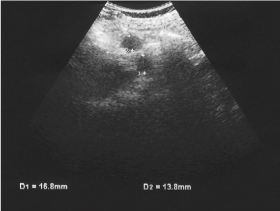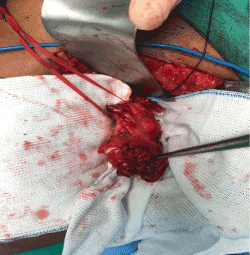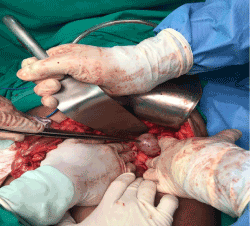Abstract
Introduction: Splenosis has been widely reported around the world with an incidence of 16-67% after traumatic splenic rupture or splenectomy, however, long term follow-up of intentional splenosis after splenectomy, ligature of the left gastric vein and auto implantation of spleen morsel in the major omentum for portal hypertension in children due to mansonic schistosomiasis (MS) is rare or not yet published. The purpose of this report is the presentation of a patient with patent splenosis in abdominal surgery for pain with the diagnosis of tail pancreas tumor. This is the first report of long-term follow-up (more than 37 years) from a child who underwent splenectomy and auto implantation off spleen morsels in the major omentum.
Case report: VL, 39-year-old, born in the north eastern region of Brazil (hyperendemic area for schistosomiasis mansoni), underwent laparotomy for abdominal pain with the diagnosis of a pancreatic mass in its tail. The preoperative image investigation (computed tomography) showed several nodules in the upper portion of abdomen and a mass in the tail of the pancreas with close relationship with the stomach. Presumptive diagnosis was pancreatic tumor (Frantz's tumor). She underwent laparotomy partial resection of the pancreas with removal of the mass, which was sent for histology. It was observed the intentional splenosis, which was anatomically very good (resembling an accessory spleen), which was not involved in the pancreas mass. Her post-operative was with no complication. In the long past (childhood) she had had splenectomy, ligature of the left gastric vein and auto implantation of spleen morsels in the major omentum when she was 13-year-old, due to esophageal hemorrhage caused by portal hypertension due to hepatosplenic Schistosomiasis mansoni. At that time, she also had hypersplenism and low body development. After surgery, she grew up as normal adolescent with no esophageal bleeding and no repeated infection nor overwhelming post splenectomy infection (OPSI). She married and gave birth of a normal child who is now 14-year-old.
Comments: This is a very successful case of auto implantation of spleen morsels in the major omentum, after splenectomy and ligature of the left gastric vein, in a patient with, at childhood, severe esophageal bleeding due to portal hypertension caused by hepatosplenic schistosomiasis mansoni. The reported case highlights the importance of maintaining some spleen tissue after splenectomy, in children, after spleen removal either due to trauma or benign disease, as it was the present report. The relationship between hepatosplenic schistosomiasis mansoni and cancer has been reported and it is under investigation.
Key words
schistosomiasis mansoni, splenectomy, splenosis, pancreatic neoplasms
Abbreviations
OPSI: Overwhelming Post Splenectomy Infection; MS: Mansonic Schistosomiasis; SM: Schistosomiasis Mansoni
Introduction
Schistosomiasis mansoni is a chronic liver disease, in which some patients progress to the most severe form (5% to 7%), hepatosplenic schistosomiasis. This form is associated with portal hypertension, splenomegaly, and often episodes of upper digestive tract bleeding, even with liver function preserved [1-4].
Splenectomy and ligature of the left gastric vein, gastric devascularization or distal splenorenal shunt are validated procedures to reduce portal hypertension following digestive bleeding in these patients [5-8]. In children, autoimplantation of spleen morsels into the major omentum is mandatory [9].
There are few reports on the fate of spleen morsels auto implantation after splenectomy in patients with portal hypertension due to schistosomiasis mansoni. Furthermore, this mean late follow-up is 12.1 ± 5.6 years. To the best of our knowledge this is the first report of a patient with esophageal bleeding due to schistosomiasis mansoni who underwent splenectomy and spleen morsels auto implantation after 37 postoperative years of the original surgical procedure. Thus, being the purpose of the scientific communication.
Case report
VL, 39-year-old, born in the north eastern region of Brazil (hyperendemic area for schistosomiasis mansoni), underwent laparotomy for abdominal pain with the diagnosis of a pancreatic mass in its tail. The preoperative image investigation (computed tomography) showed several nodules in the upper portion of abdomen (Figure 1) and a mass in the tail of the pancreas with close relationship with the stomach.

Figure 1. Spleen nodules seen on ultrasound
Presumptive diagnosis was pancreatic tumor (Frantz's tumor). She underwent laparotomy partial resection of the pancreas with removal of the mass, (Figure 2) which was sent for histology.

Figure 2. Surgical specimen of the pancreas tail and the tumor
It was observed the intentional splenosis, which was anatomically very good (resembling an accessory spleen), which was not involved in the pancreas mass (Figure 3).

Figure 3. Spleen nodule, resembling an accessory spleen, just below the greater gastric curvature. A site where a spleen morsel was implanted 37 years ago
Apart from surgical wound infection, her post-operative was with no complication. In the long past (childhood) she had had splenectomy, ligature of the left gastric vein and auto implantation of spleen morsels in the major omentum when she was 13-year-old, due to esophageal hemorrhage caused by portal hypertension due to hepatosplenic Schistosomiasis mansoni. At that time, she also had hypersplenism and low body development. After surgery, she grew up as normal adolescent with no esophageal bleeding and no repeated infection nor overwhelming post splenectomy infection (OPSI). She married and gave birth of a normal child who is now 14-year-old. In the pre-operative period she was assessed for blood cell count, especially for lymphocyte blood and immunoglobulin levels, which revealed: absolute lymphocyte count 1,484/mm3; total T absolute lymphocyte CD3+ 831/mm3 – 56%; T auxiliary lymphocyte CD4 (CD3+CD4+) 490/mm3 - 33%; T suppressor lymphocyte CD8 (CD3+CD8+) 282/mm3 – 19%; CD4/CD8 ratio 1.74; lymphocyte B CD19+ 178/mm3 – 12%; sub population CD3-/CD16+/CD56+ 312/mm3. The immunoglobulin assessment showed: rubella IgG antibody – 113.0 UI/ml, rubella IgM antibody – 127 mg/100ml; total IgE 66IU/ml; IgG -1,471 mg/100ml; IGA - 302 mg/100ml. Although CD4 (CD3+CD4+) 490/mm3 was at the level of immunosuppression, all other lymphocyte counts, and immunoglobulin levels were within the reference confident interval for her age. She presented with no signs of hypersplenism.
Comments
The schistosomiasis mansoni (SM) is endemic in the northeastern region of Brazil, and its main factor of morbidity is the portal hypertension, which occur in about 5% of the patients. In the severe cases of bleeding from esophageal varicose veins, surgery is the treatment for portal decompression, generally including splenectomy, which reduces portal hypertension decreasing the risk of posterior bleeding [1,5-10]. Auto implantation of spleen morsels in the major omentum has the potential to reduce the risk of overwhelming postsplenectomy infection (OPSI) [9,10].
The proved splenosis, in this patient, was surrounded by splenic capsule (accessory spleen). This is a very interesting finding because the spleen morsels auto implanted thirty-seven years ago had no capsule, which raises the question of splenic regeneration. Until now, spleen functionality, in splenosis, is assessed by splenic regeneration. However, the issue still remains an interesting pathological aside whose benefit to patients remains an enigma and societal value unexploited [11,12].
The peripheral blood cell count of this patient was within the normality, which was interpreted as she cured of her hypersplenism that existed previous to original surgery and she was in hematologic good condition for undergoing major surgery.
As regard to low CD4 lymphocyte in this patient, it should not be taken as exclusion criteria for surgical intervention as it not happens in cancer and HIV/AIDS patients [13,14]. The management of immunodeficiency in surgical patients and the use of anesthetic substances need further study [13]. Furthermore, surgical procedures in HIV/AIDS patients require good expertise both in surgery and in infectology [13,14].
The relationship between hepatosplenic schistosomiasis and cancer has been investigate and, equally, requires further studies [15,16]. The present report should be taken into consideration for future epidemiological investigations on this subject especially regarded to immunology.
References
- Leite LA, Filho AAP, Ferreira Rde C, da Fonseca CS, dos Santos BS, et al. (2015) Splenectomy improves hemostatic and liver functions in hepatosplenic Schistosomiasis Mansoni. PLoS One 10: e0135370. [Crossref]
- Lambertucci JR (2014) Revisiting the concept of hepatosplenic schistosomiasis and its challenges using traditional and new tools. Rev Soc Bras Med Trop 47: 130-136. [Crossref]
- Leite LA, Domingues AL, Lopes EP, Ferreira R de C, Ade A Filho P, et al. (2013) Relationship between splenomegaly and hematologic findings in patients with hepatosplenic schistosomiasis. Rev Bras Hematol Hemoter 35: 332-336. [Crossref]
- Dias HS, Domingues AL, Cordeiro FT, Jucá N, Lopes EP (2013) Associating portal congestive gastropathy and hepatic fibrosis in hepatosplenic mansoni schistosomiasis. Acta Trop 126: 240-243. [Crossref]
- Miranda MA, Ferraz ÁA, Domingues AL, Chaves RC, Jucá N, et al. (2013) Improvement of schistosomal portal hypertensive colopathy after surgical treatment. Arq Gastroenterol 50: 153-156. [Crossref]
- Batista-Neto J, Tognetti LB, Ribeiro LT, Balwani Mdo C, Muritiba T, et al. (2013) Evolutional profile of the esophageal varices after splenectomy associated with ligation of the left gastric vein and sclerotherapy in schistosomal portal hypertension. Arq Bras Cir Dig 26: 49-53. [Crossref]
- Evangelista-Neto J, Pereira FF, França ST, Amaral FJ, Brandt CT, et al. (2012) Splenectomy and gastric vein ligature in hepatosplenic schistosomiais: effects upon esophageal variceal pressure and endoscopic risk factors of esophageal variceal bleeding. Arq Bras Cir Dig 25: 41-48. [Crossref]
- de Cleva R, Herman P, D'albuquerque LA, Pugliese V, Santarem OL, et al. (2007) Pre- and postoperative systemic hemodynamic evaluation in patients subjected to esophagogastric devascularization plus splenectomy and distal splenorenal shunt: a comparative study in schistomomal portal hypertension. World J Gastroenterol 13: 5471-5475. [Crossref]
- Brandt CT, Leite CR, Manhaes-de-Castro FM, Macedo EM, Silva RP, et al. (2006) Nitric oxide monocyte production levels in patients with the hepatosplenic form of schistosomiasis mansoni who underwent splenectomy, ligature of the left gastric vein and auto implantation of spleen tissue in the major omentum. Acta Cir Bras 21: 285-290.
- Brandt CT, Brandão SC, Domingues AL, Gondra LA, Viana RA (2012) Splenosis after splenectomy and spleen tissue autoimplantation: Late followup study. J Indian Assoc Pediatr Surg 17:104-106. [Crossref]
- Riera M, Buczacki S, Khan ZA (2009) Splenic regeneration following splenectomy and impact on sepsis: a clinical review. J R Soc Med 102: 139-142. [Crossref]
- Khan ZA, Dikki PE (2004) Return of a normal functioning spleen after traumatic splenectomy. J R Soc Med 97: 391-392. [Crossref]
- Chen Y, Liang M, Zhu Y, Zhou D (2015) The effect of propofol and sevoflurane on the perioperative immunity in patients under laparoscopic radical resection of colorectal cancer. Zhonghua Yi Xue Za Zhi 95: 3440-3444. [Crossref]
- Ferreira MD, Collaniere AC, Bertolini DL, Barros NC, Vasconcelos DM (2017) Cellular immunodeficiency related to chronic dermatophytosis in a patient with Schistosoma mansoni infection: can schistosomiasis induce immunodeficiency? Rev Soc Bras Med Trop 50: 141-144. [Crossref]
- Azevedo P, Pedrosa MS, Resende V (2015) Gastroenterology: Hepatosplenic T cell lymphoma associated with schistosomiasis. J Gastroenterol Hepatol 30: 1333. [Crossref]
- Ferraz AA, de Sá VC, Lopes EP, de Araújo JG Jr, Martins AC, et al. (2006) Lymphoma in patients harboring hepatosplenic mansonic schistosomiasis. Arq Gastroenterol 43: 85-88.



